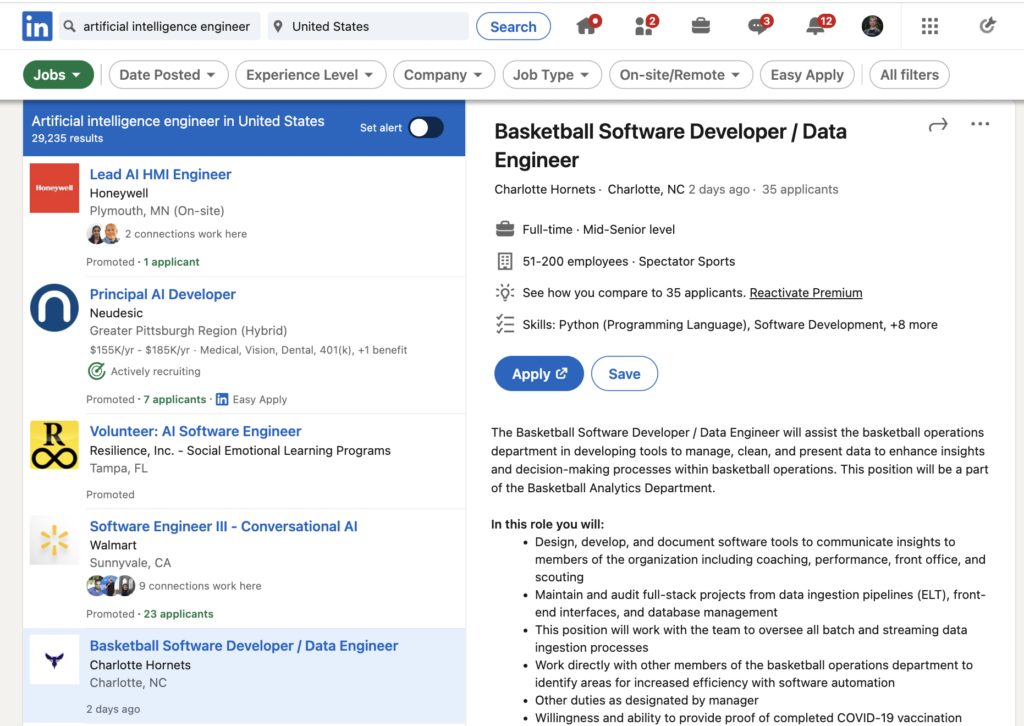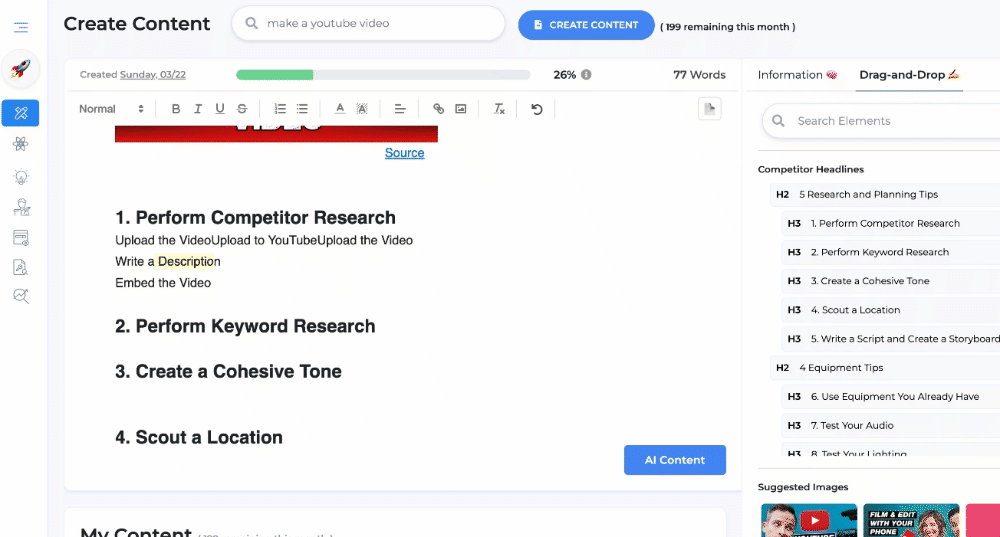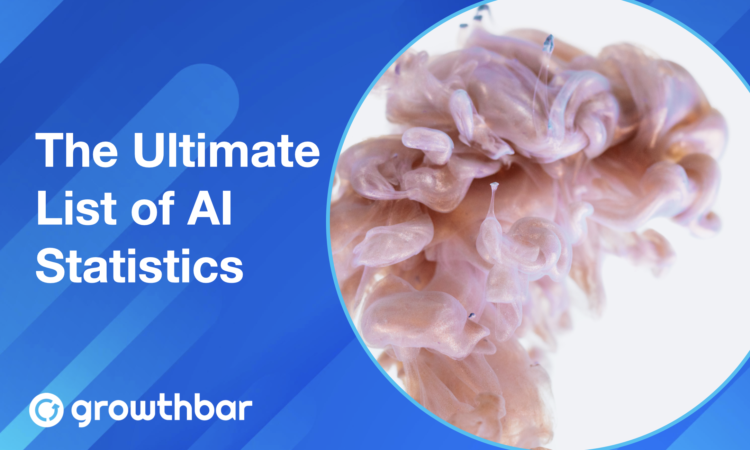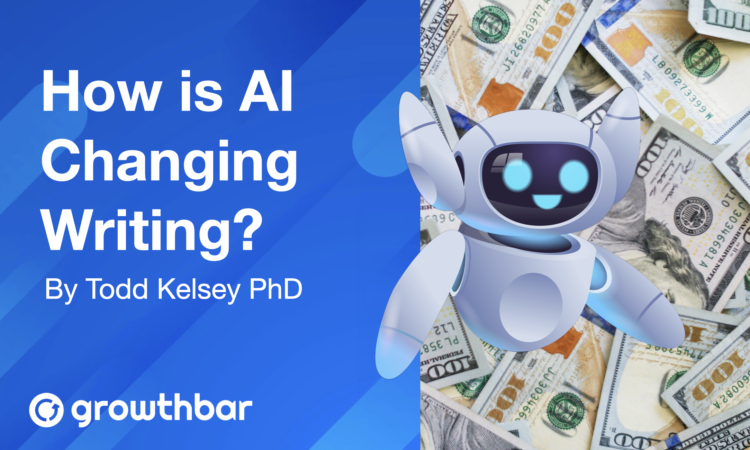- Write With AI in Your Brand’s Voice with GrowthBar - April 21, 2023
- How Long Should a Blog Post Be? [2024] - April 14, 2023
- 13+ Best ChatGPT Prompts for SEOs [2024] - April 14, 2023
Ended soon
Artificial intelligence is changing our lives daily and shows no signs of stopping.
Believe it or not, AI is at your fingers right now, in your phone, and on your computer; whenever you use the self-checkout at the grocery store or make an online purchase, artificial intelligence is behind a lot of that.

Statistics show that AI technology will drastically shift the economy and global market. We will see jobs created and taken away as more companies continue to invest in AI. In fact, it’s already started! On my Twitter feed just recently, Scale AI announced the hiring of a prompt engineer — the first ever, according to its CEO. A prompt engineer basically plays with the inputs into AI engines to optimize the algorithm’s outputs.

So we’ve put together this ultimate list of AI stats within this decade and the coming years to show how much AI has and will accomplish.
Also read: 5 Ways AI is Changing Writing or Try our FREE AI Writing Tool
Table of Contents
Statistics About the Global AI Market
1. By 2030, AI will have made 15.7 trillion for the worldwide economy.
With the workforce starting to lean into the benefits of adopting artificial intelligence, AI will contribute 15 trillion dollars to the global economy.
So what does this mean?
AI’s fast-paced growth will continue contributing to the economy and changing lives. Self-driving cars could help those with physical disabilities get from point A to B. Digital assistants that can coordinate and plans meeting around your schedule. Or Voice AI that can type your essays for you. Artificial intelligence can and will continue to change the way of working and our economy.
2. Limited amount of AI experts is the market’s biggest obstacle
Despite all its achievements and accolades, AI is still fairly new to companies. A big reason why companies aren’t adopting AI is due to the lack of AI experts. Yes, there are plenty of benefits when incorporating AI into systems, but there is also the risk of AI not performing as it should. This could cost companies a lot of money and potentially lose loyal consumers.
The limited number of AI experts is seen to be a major obstacle to the AI market’s growth. The lack of experts prevents companies from fully utilizing AI and limits the development of new applications. The lack of experts also makes it difficult to find the talent needed to create and maintain an AI system.
There are 29,235 “artificial intelligence engineer” jobs available on LinkedIn. Everyone from Walmart to the Charlotte Hornets basketball team are hiring AI engineers!

3. North America is predicted to hold the largest AI market share
North America is home to an impressive tech industry with giants like Apple, Microsoft, Tesla, and Google. We shouldn’t be shocked to learn that it will also soon house the largest AI market.
With the government’s ongoing funding for research at major universities, we can expect a great breakthrough in the continent. The money will be a beacon for engineers, scientists, and more to come to North America and make a career for themselves. This is going to create a surge of AI tech start-ups and give competitors some competitive edge to make the most accurate and efficient AI possible.
4. Global AI-driven hardware is expected to grow over $200 billion by 2025
AI-driven hardware will increase by 200 billion by the year 2025. Think about the evolution of computing and how much things have changed from the start of this millennium.
Computer processing units (CPU) and graphic processing units (GPU) are the foundation for creating learning applications, video games, and much more. With AI, CPUs and GPUs are performing more tasks than ever, and we see the results. Games look more realistic, and most have gotten rid of the old-fashioned loading screen. We can simultaneously run multiple applications on our computers, phones, and laptops. AI-driven hardware has also increased work performance in the office and will continue to do so the more it evolves.
5. AI Industry market size will be worth $226.92 billion in 2027
With the rise of cloud-based apps and more people shopping for products online, the AI market size will see a tremendous boom by 2027. On top of that, cybercrime prevention is needed now more than ever. Due to the same usage of cloud-based apps and online shopping, scammers and identity theft have become extremely common.
This has given AI the opportunity to detect and warn people if they are on sketchy websites or potentially providing a scammer with their personal and financial information.
Statistics About Generative AI
What is Generative AI?
Before we dive into more stats and numbers, what is Generative AI, and what can it do?
Generative AI is a subset of AI that deals with generating new data or new content. This can be in the form of text, images, or even video. Generative AI is also used to create new data that can be used to train other AI models.

6. By 2025, Generative AI will have produced 10% of all data
Generative AI is a double-edged sword taking the AI market by storm. You can use Generative AI to create new content as it scans and takes information from existing videos, images, and texts. Most companies use AI to help make copy for social media and emails. More seriously, Generative AI has made it easier to perform scams, spread misinformation, and create fake identities.
Regardless of the use, it cannot be denied how much Generative AI will be responsible for a significant portion of all content.
7. The ROI of AI is high among 71% of respondents and their organizations
According to a recent survey, the ROI of AI is high among 71% of respondents, and their organizations are already using AI. This suggests that AI is becoming increasingly important for businesses and that they are seeing the benefits of using AI. With the rapid development of AI technology, it is likely that the ROI of AI will continue to increase as businesses find more ways to use AI to improve their operations.
Businesses and organizations have seen promising results having invested in Generative AI. Production development and performance are shattering expectations and allowing companies to make more money. This is why we see so many companies report their ROI as “high or very high.”
8. The forecasted AI annual growth rate is 33.2 between the years 2020 and 2027
The global artificial intelligence market is projected to grow from $24.6 billion in 2020 to $103.6 billion by 2025, at a CAGR of 33.2%. The increase in demand for AI-based services in various industry levels is expected to drive the growth of the AI market.
AI is in high demand in various industries, such as healthcare and automotive. Self-driving cars are becoming popular and could help those with disabilities. Generative AI is also a new great source for the medical industry through diagnostics, precision medicine, and drug discovery.
9. Generative AI may increase product development efficiency by 30%
Major companies are taking advantage of AI’s ability to produce quicker and more efficiently than humans. Companies can use Generative AI to create a more positive customer experience as it can identify any issue that interferes with usability. On top of this, AI can also predict the demand for a product, such as how much needs to be made and could possibly be sold.
This goes for content creation too. We are seeing companies churn out media content faster than before and in good quality too.
10. 90% of material in quarterly reports will be generated synthetically by 2025
FP&A professionals might be scared to hear this one. Generative AI can create its own authentic content within seconds. The best AI tools can research a topic, find the most salient information, and write paragraphs in minutes.
Statistics About AI Digital Assistants
What Are Digital AI Assistants?
A digital AI assistant is a computer program that can perform tasks or services for an individual. These tasks can range from simple tasks like setting alarms to more complex tasks like scheduling meetings. There are many different digital AI assistants available on the market, each with its unique features and capabilities.
(P.S. You probably have one in your pocket.)
11. AI Voice assistant is anticipated to be used by 55% of users with hands-free devices
Voice AI on mobile devices makes it easier to call and text people, use search engines, and set up schedules and reminders when our hands aren’t free. The Pew Research Center predicts that voice-generated AI will become a prominent force in our lives in the very near future.
12. 40% of users claim to use Voice AI at least once a day
How many times have you asked Siri a question today? Just a little under half of mobile device user claim to have used their voice assistant to use a search engine, make a call, set a timer, or send a text. Siri converts the acoustic pattern of your voice into a probability distribution of speech sounds — so even when you’re sipping a latte, Siri usually know what you’re saying.

13. 22% of users have used their AI Voice to type
A recent study found that 22% of users have used their AI Voice to type. People using Voice AI find it more natural to use the voice assistant rather than typing out what they want to say. This could be due to the fact that voice assistants are becoming more advanced and can understand different accents and dialects.
14. 97% of users with a mobile phone have used an AI Voice assistant.
AI voice assistants are becoming increasingly popular, with 97% of mobile phone users using one. A study performed by IDAP has concluded that only 2% of iPhone owners have never accessed Siri, while 4% of Andriod users have not used their Googe assistant in any way. The popularity of these assistants is likely due to the convenience and hands-free nature they offer users. With so many people using these assistants, businesses are starting to take notice and put them into their marketing strategies.
15. Almost half of Americans regularly use voice assistants
Voice assistants are accessible because they are not only on most mobile phones but in computers, laptops, and tablets. Not to mention Americans who own more audio-centric devices such as Google Home and Amazon’s Echo.
In addition to Voice AI being in our homes and making our errands easier, it is also a tremendous learning tool. Applications like Duolingo allow people to learn a new language at their own pace instead of registering for a course and having a teacher.
Statistics Related to AI In Sales
16. AI helps businesses earn 20% EBIT minimum when it comes to sales strategies
EBIT, or Earning Before Interest and Taxes, helps companies measure their growth, and some companies are reporting AI has helped them increase by 20% minimum. Depending on the sales strategies, AI may have a good impact on the EBIT because of increased production rates.
AI can help with sales planning, target market analysis, and customer segmentation. All these things can lead to increased sales and, as a result, increased EBIT. Plus, once created, the marginal cost of running AI models is rather low. Yes, training models can get really pricey, but running them is a high-margin business.
This also has created better savings costs because of the upped production rate and quality.
17. AI is being used more commonly in customer service and customer segmentation
Customer service is changing with the help of AI and its ability to make real-time decisions and offer immediate solutions. Through data mining, AI also keeps tabs on personal preferences so that customers only recommend things they like. With the data provided by AI, companies can run sales strategies that are more likely to be successful. An example would be suggesting an item similar to what the customer has bought. It helps build emotional connections between the company and the customer.
18. Chatbots increase sales by 67% on average
I’m a little wary of this fact, but I’ve definitely seen an uplift in some businesses due to chatbots. AI technologies are becoming crucial in business because they offer the ability to improve product development by understanding customer needs and preferences. Companies are seeing that consumers have grown accustomed to seeing some kind of digital helper when they make an online purchase. In most cases, the digital helper makes sit easier to complete a transaction which is why they see a jump in sales.
Additionally, AI can automate product development, from ideation to prototyping to testing. This automation can help businesses save time and money while still delivering high-quality products.
19. By 2025, 60% of B2B sales organizations will become more data-driven instead of relying on experience and intuition
Companies are starting to adopt AI-driven systems to better their consumer experience. Instead of having multiple channels for sales, businesses will try to build a system that can handle sales processing, sales applications, sale data, and sale analytics all at once. The AI will collect data and better accommodate the consumer whenever they make a purchase.
20. 14 to 80 million U.S. jobs are at risk of being automated
This one is scary. There’s no doubt that AI is a powerhouse. Since AI constantly evolves, the more technology advances, it has incredible diversity. AI can develop new content, scan for internal errors, collect data, and perform essential everyday tasks, and we could see millions of jobs at risk in the near future.
Companies can increase their production rates, sales, and quality of products with the help of AI, and they can do it faster than ever.
Why AI Technologies are Becoming Crucial In Business
AI technologies are becoming crucial in business for a number of reasons. First, AI can help businesses automate tasks and processes, freeing up employees to focus on more strategic work. Second, AI can help businesses make better decisions by providing data and insights that humans may not be able to see. Finally, AI can help businesses improve customer service and develop more personalized experiences for customers.
- Acquiring customers: AI technologies are becoming crucial in business because they enable businesses to make smarter decisions, use sales technologies more effectively, and generate leads more cheaply. Companies can save time and money by using AI to make decisions while acquiring new customers. Additionally, AI-enabled sales technologies can help businesses close deals faster and more efficiently. Finally, generative AI can help businesses create new leads and customers more quickly and easily.
- Retaining customers: AI can be used to personalize the customer service experience and offer recommendations in real-time. AI can also be used to automate customer service tasks, like answering common questions and resolving simple issues. AI-powered chatbots can communicate with customers on behalf of businesses and help them with tasks like customer service, making recommendations, and even closing sales. By automating some of the customer acquisition processes, businesses can free up time and resources to focus on other areas of their business.
- Increasing upsells: AI can be used to identify upsell and cross-sell opportunities, as well as to personalize the sales experience for each customer. By identifying opportunities and automating the sales process, businesses can make more sales and improve their bottom line. Additionally, AI can be used to personalize the sales experience for each customer. This allows companies to build stronger customer relationships and enhance customer loyalty.
- Improving product marketing: There are a number of reasons why AI technologies are becoming crucial in business. One of the most important is that AI can be used to improve marketing efforts by understanding customer behavior and preferences. AI can also automate marketing tasks, like segmenting customers, creating targeted campaigns, and measuring results. This can lead to more effective and efficient marketing, which can be a significant competitive advantage. Additionally, AI can help businesses automate tasks like customer service, accounting, and HR. This can help companies to save time and money and improve their overall efficiency.
- Building better products: We are seeing a trend of AI technologies becoming increasingly crucial in business. The reason for this is AI’s ability to automate and improve various business processes. For example, AI can be used to improve product development by understanding customer needs and preferences. AI can also be used to automate the product development process, from ideation to prototyping to testing. In addition, AI can be used to improve customer service, sales, and marketing processes. By automating these processes, businesses can save time and money and improve their products and services.
- Managing finances: AI can be used to improve financial decision-making by understanding market trends and identifying opportunities. AI can be used to improve financial decision-making by understanding market trends and identifying opportunities. AI can also help reduce costs by automating tasks such as fraud detection and financial analysis.AI technologies are becoming increasingly crucial in managing finances for several reasons. Firstly, AI can improve financial decision-making by understanding market trends and identifying opportunities. Secondly, AI can help reduce costs by automating fraud detection and financial analysis tasks. Finally, AI can improve the efficiency of financial processes by streamlining data collection and analysis. Overall, AI provides many advantages for businesses when it comes to managing finances.
Conclusion
AI is a powerhouse already shifting the economy and will continue to do so as more companies start embracing artificial intelligence. Artificial intelligence will become the new face of the fourth industrial revolution and contribute to creating and destroying jobs in multiple industries. Expect a vast difference in how we perform our jobs and daily tasks in the next few years.




